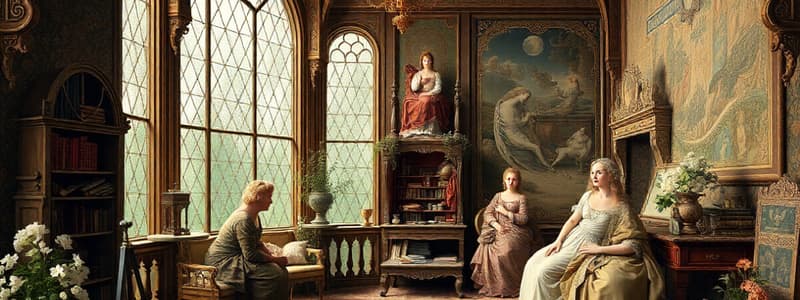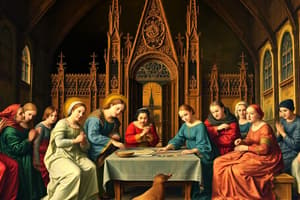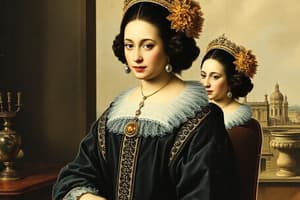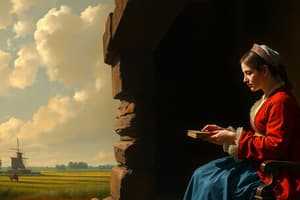Podcast
Questions and Answers
What was the primary basis for art production in the Dutch Republic?
What was the primary basis for art production in the Dutch Republic?
- Exclusive commissions from wealthy clients
- State commissions
- Private patronage and an open market (correct)
- Church commissions
Which type of painting became a staple of seventeenth-century Dutch painting?
Which type of painting became a staple of seventeenth-century Dutch painting?
- Still lifes
- Portraits
- Landscapes (correct)
- Abstract art
What does the imagery of the two sisters symbolize in relation to North and South?
What does the imagery of the two sisters symbolize in relation to North and South?
- The age of conflict
- A hopeful union (correct)
- Their ongoing rivalry
- The rise of art
What significant trend emerged among artists in the Dutch Republic during the late sixteenth century?
What significant trend emerged among artists in the Dutch Republic during the late sixteenth century?
Which subjects were most favored by art buyers in the Dutch Republic?
Which subjects were most favored by art buyers in the Dutch Republic?
What does the phrase 'Slapende Mars' refer to?
What does the phrase 'Slapende Mars' refer to?
How does the text describe the economic situation during the period of peace?
How does the text describe the economic situation during the period of peace?
What was the relationship between the open art market and the emergence of painting specializations?
What was the relationship between the open art market and the emergence of painting specializations?
Which artist's work exemplified the artistic choices related to landscape painting?
Which artist's work exemplified the artistic choices related to landscape painting?
What motivated the creation of specific types of paintings during this period?
What motivated the creation of specific types of paintings during this period?
What observation did Peter Mundy make about the art of painting in the Netherlands?
What observation did Peter Mundy make about the art of painting in the Netherlands?
Which of the following factors contributed to the increase in the number of paintings in the Dutch Republic?
Which of the following factors contributed to the increase in the number of paintings in the Dutch Republic?
What characterized the Dutch art scene in comparison to that of Flanders?
What characterized the Dutch art scene in comparison to that of Flanders?
How did people acquire paintings in the Republic?
How did people acquire paintings in the Republic?
What is indicated by the phrase 'historical pieces, landscapes, seascapes, etc.' regarding the types of paintings?
What is indicated by the phrase 'historical pieces, landscapes, seascapes, etc.' regarding the types of paintings?
What aspect of the market influenced the production of paintings?
What aspect of the market influenced the production of paintings?
What was one of the main issues faced by the black people living in the area described?
What was one of the main issues faced by the black people living in the area described?
How many paintings of Post were some individuals reported to have owned?
How many paintings of Post were some individuals reported to have owned?
What genre of painting is Jan van Goijen primarily associated with?
What genre of painting is Jan van Goijen primarily associated with?
What element does the artist use to create a dramatic contrast in his works?
What element does the artist use to create a dramatic contrast in his works?
Which artist is noted for having a unique perspective, as if viewed from a bird's eye view?
Which artist is noted for having a unique perspective, as if viewed from a bird's eye view?
How does the portrayal of the landscape by Albert Cuyp differ from that of Van Goijen?
How does the portrayal of the landscape by Albert Cuyp differ from that of Van Goijen?
What is suggested as a shift in art patronage during the time of the wealthy merchant class?
What is suggested as a shift in art patronage during the time of the wealthy merchant class?
What aspect of composition do both Ruysdael and Van Goijen emphasize according to the content?
What aspect of composition do both Ruysdael and Van Goijen emphasize according to the content?
Who are mentioned as representative landscape painters alongside Jan van Goijen?
Who are mentioned as representative landscape painters alongside Jan van Goijen?
What were produced as a result of the desire for landscapes similar to Brueghel's works?
What were produced as a result of the desire for landscapes similar to Brueghel's works?
What influence does Van Goijen have on the artist discussed in the content?
What influence does Van Goijen have on the artist discussed in the content?
What is a characteristic feature of Cuyp's paintings mentioned in the content?
What is a characteristic feature of Cuyp's paintings mentioned in the content?
Which aspect of Dutch landscape painting is emphasized in the text?
Which aspect of Dutch landscape painting is emphasized in the text?
What does the artist use as a key feature in his large landscapes?
What does the artist use as a key feature in his large landscapes?
In the depiction of landscapes, what does the large windmill represent in comparison to the people?
In the depiction of landscapes, what does the large windmill represent in comparison to the people?
What method does the artist primarily use to construct his landscapes?
What method does the artist primarily use to construct his landscapes?
What was a significant factor that contributed to the increase in the number of painters in the early 17th century in the Netherlands?
What was a significant factor that contributed to the increase in the number of painters in the early 17th century in the Netherlands?
Why was it advisable for painters to keep their iconography and style relatively general?
Why was it advisable for painters to keep their iconography and style relatively general?
What trend did painters adopt to stand out in an increasingly competitive environment?
What trend did painters adopt to stand out in an increasingly competitive environment?
What is emphasized about the artist's process in creating paintings?
What is emphasized about the artist's process in creating paintings?
What aspect of perspective is noted in the artist's work?
What aspect of perspective is noted in the artist's work?
Which artist is known for exclusively painting Brazilian landscapes after visiting Brazil?
Which artist is known for exclusively painting Brazilian landscapes after visiting Brazil?
What does the specialization of painters in genres such as landscapes and seascapes indicate about the art market?
What does the specialization of painters in genres such as landscapes and seascapes indicate about the art market?
How is the use of color described in the artist's paintings?
How is the use of color described in the artist's paintings?
What type of market emerged for paintings due to the factors discussed?
What type of market emerged for paintings due to the factors discussed?
What is noted as a technique used for convincing representation in the artist's landscapes?
What is noted as a technique used for convincing representation in the artist's landscapes?
Which painter is associated with only painting winter scenes?
Which painter is associated with only painting winter scenes?
What can be inferred about the artist's distribution of works?
What can be inferred about the artist's distribution of works?
Which artist's influence is mentioned in developing the style of Van Goijen?
Which artist's influence is mentioned in developing the style of Van Goijen?
What was an innovative subject matter depicted by Frans Post in his paintings?
What was an innovative subject matter depicted by Frans Post in his paintings?
What denotes the composition techniques observed in Ruysdael's works?
What denotes the composition techniques observed in Ruysdael's works?
What is indicated about the common perception of painting at the time?
What is indicated about the common perception of painting at the time?
Flashcards
Dutch art market
Dutch art market
The Dutch art market in the 17th century was driven by private patronage and an open market, where paintings became a commodity traded based on supply and demand.
Specialization in Dutch art
Specialization in Dutch art
Artists in the Dutch Republic specialized in particular subjects, like landscapes, still lifes, and genre scenes, catering to the preferences of art buyers.
Landscapes in Dutch art
Landscapes in Dutch art
Landscapes became a popular specialty in Dutch painting, representing both familiar local views and imaginative visions of nature.
Jan van Goyen
Jan van Goyen
Signup and view all the flashcards
Albert Cuyp
Albert Cuyp
Signup and view all the flashcards
Jacob van Ruisdael
Jacob van Ruisdael
Signup and view all the flashcards
Dutch art market impact
Dutch art market impact
Signup and view all the flashcards
Landscape Genre
Landscape Genre
Signup and view all the flashcards
Early Dutch Landscape Painting
Early Dutch Landscape Painting
Signup and view all the flashcards
Brueghel's High Vantage Point
Brueghel's High Vantage Point
Signup and view all the flashcards
The Influence of Wealthy Patrons
The Influence of Wealthy Patrons
Signup and view all the flashcards
The Rise of Landscape Prints
The Rise of Landscape Prints
Signup and view all the flashcards
Golden Age of Dutch Art
Golden Age of Dutch Art
Signup and view all the flashcards
Iconography
Iconography
Signup and view all the flashcards
Patronage
Patronage
Signup and view all the flashcards
Dutch Golden Age Art Market
Dutch Golden Age Art Market
Signup and view all the flashcards
Domestic Art Ownership
Domestic Art Ownership
Signup and view all the flashcards
Genre Painting
Genre Painting
Signup and view all the flashcards
Art as an Investment
Art as an Investment
Signup and view all the flashcards
Accessibility of Art
Accessibility of Art
Signup and view all the flashcards
Rise of Painting Demand
Rise of Painting Demand
Signup and view all the flashcards
Increased Artist Competition
Increased Artist Competition
Signup and view all the flashcards
Anonymous Audience
Anonymous Audience
Signup and view all the flashcards
Iconography for the Masses
Iconography for the Masses
Signup and view all the flashcards
Specialization and Niche Markets
Specialization and Niche Markets
Signup and view all the flashcards
Frans Post: Brazilian Explorer-Painter
Frans Post: Brazilian Explorer-Painter
Signup and view all the flashcards
Impact of Specialization on Demand
Impact of Specialization on Demand
Signup and view all the flashcards
Frans Post's Innovations
Frans Post's Innovations
Signup and view all the flashcards
What does the text suggest about the artist's approach?
What does the text suggest about the artist's approach?
Signup and view all the flashcards
How did the artist achieve a sense of 'toevalligheid' (coincidence)?
How did the artist achieve a sense of 'toevalligheid' (coincidence)?
Signup and view all the flashcards
What technique did the artist use to create the illusion of depth?
What technique did the artist use to create the illusion of depth?
Signup and view all the flashcards
What does 'misleiding' (deception) refer to in the context of the artist's work?
What does 'misleiding' (deception) refer to in the context of the artist's work?
Signup and view all the flashcards
How was the artist's approach influenced by other artists?
How was the artist's approach influenced by other artists?
Signup and view all the flashcards
What is the connection between the artists Van Goijen and Van Ruysdael?
What is the connection between the artists Van Goijen and Van Ruysdael?
Signup and view all the flashcards
What commonality exists between artists like Ruysdael and Cuyp?
What commonality exists between artists like Ruysdael and Cuyp?
Signup and view all the flashcards
Why was the speed of drying paint important for the artist?
Why was the speed of drying paint important for the artist?
Signup and view all the flashcards
Cuyp's Light
Cuyp's Light
Signup and view all the flashcards
Dramatic Landscapes
Dramatic Landscapes
Signup and view all the flashcards
Goyen's Influence
Goyen's Influence
Signup and view all the flashcards
Shared Techniques
Shared Techniques
Signup and view all the flashcards
Artistic Development
Artistic Development
Signup and view all the flashcards
Emphasis on Scale
Emphasis on Scale
Signup and view all the flashcards
Cuyp's Style
Cuyp's Style
Signup and view all the flashcards
Van Goyen's Light
Van Goyen's Light
Signup and view all the flashcards
Study Notes
New Market for Paintings and Specializations in Northern Netherlands
- Paintings were common in shops and homes.
- Women were significant purchasers of paintings.
- Art in the Dutch Republic relied heavily on private patronage and an open market
- Paintings were a commodity
- Paintings ranged in size (small enough to hold or large enough for homes)
- Landscapes, architectural, still-life, and genre scenes were popular subjects in the Dutch Republic
- Specialization in painting arose as subjects developed fully
- Landscape painting was a significant speciality throughout the 17th century, portraying both familiar and imaginative views.
The Role of the Market and Specialization in Painting
- The emergence of the open market influenced specialization and the rise of painters.
- The Dutch Republic experienced significant growth in the number of paintings.
- A shift in the location of wealth and artistic activity occurred. This shifted from the Southern Netherlands towards the North.
- The Dutch Republic experienced a period of prosperity until the French/English invasion of 1672
Historical Situation in the Northern Netherlands, c. 1568-1648
- The period saw increasing wealth, urbanization, and trade within the Northern Netherlands
- The Dutch Revolt (started 1566) marked a shift towards the North, which led to a boom in Amsterdam and other Northern cities
- The Twelve Year's Truce (1609-1621) had a significant positive impact on the North
- The Dutch Republic gained independence in 1648, leading to a period of significant prosperity.
The Paintings Themselves
- Demand and use of paintings changed and the need for new painting specializations arose -Jan van Goyen, a key example, focused on Dutch landscapes.
- Artists began to adapt and innovate, creating new styles like the ones by Albert Cuyp and Jacob van Ruisdael.
The Historical Context
- Artistic activity and wealth initially centered around Bruges and Antwerp in the Habsburg territories
- The shift towards Northern cities (like Amsterdam) occurred during the 16th century.
- The iconography portrayed a desire for peace and unity or for a unified Netherlands in times of conflict
Studying That Suits You
Use AI to generate personalized quizzes and flashcards to suit your learning preferences.
Related Documents
Description
Explore the vibrant art market that flourished in the Northern Netherlands, particularly focusing on the 17th century. This quiz delves into the roles of private patronage, various art subjects, and the impact of women's purchasing power. Understand how specialization in painting evolved alongside market demands during this significant period.




